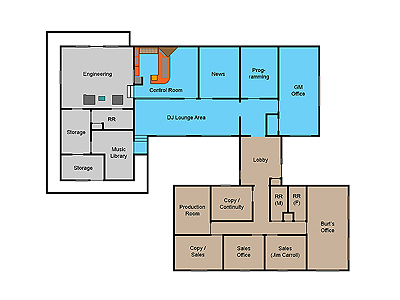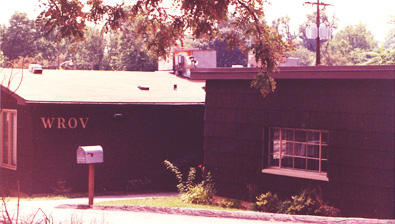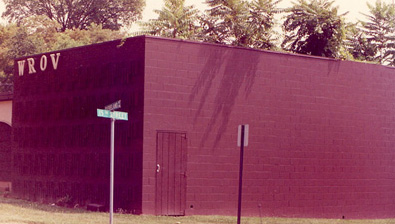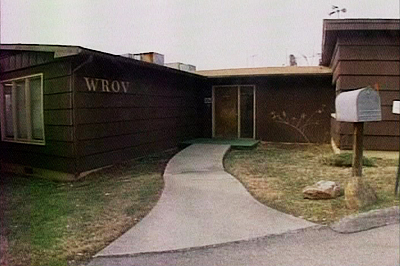
| Click the picture to see a larger view in a separate window. |

| Click the picture to see a larger view in a separate window. |
The WROV building, once located at 15th Street & Cleveland Avenue in Roanoke, was built in three stages: the "Quonset Hut" (shown in gray), the "Concrete Flat" (blue), and the "Jim Walters Home" section (tan). A fourth edition known as the "Doublewide" was added after Burt sold the station and is not included in the diagram but can be seen in the overhead view below, to the right of the "Jim Walters Home" section. The diagram shows it as it was in the 1970s-1980s.
The "Quonset Hut" was first and was built to house the transmitting equipment when the station went on the air in 1946. According to the Wikipedia "A Quonset hut is a lightweight prefabricated structure of corrugated galvanized iron having a semicircular cross section. The design was based on the Nissen hut developed by the British during World War I. The name comes from their site of first manufacture, Quonset Point, at the Davisville Naval Construction Battalion Center in Davisville (a village located within the town of North Kingstown, Rhode Island). Given that the WROV "Hut" was built in 1946, we suspect that it likely was one no longer needed after World War II, which was sold to Roanoke Radio, Inc by the U.S. Army.
Beginning in 1955, when the station was purchased by Burt Levine, the studios moved here from the Mountain Trust Bank building downtown. In the spirit of cost cutting, also consistent with Burt's correct belief that radio was moving away from the big-studio live music shows of its "golden years" to the era of one-man DJ shows, the station operated out of the "Hut." There are varying opinions of how long the station operated under this arrangement. From what we're able to piece together from those who were there, from news stories and other sources, we think that the radio stations moved out of the Mountain Trust Bank building around or shortly after WDBJ-TV went on the air and began broadcasting from the MTB studios in October, 1955. The 1956 Broadcasting Yearbook, dated February 20, 1956, shows the studio address as being "15th Street at Cleveland" so they were—at least—receiving the mail there by that date.

| This World War II Quonset hut looks just like the one at 15th & Cleveland from 1946 through 2004. |
The WROV "Hut" was very much like the one in the above picture, which we use courtesy of the U.S. Army Corps of Engineers web site. The front and back had one door with windows on each side. Employees and visitors generally parked behind the hut and entered through the rear door. Three windows adorned each side of the hut. Military Quonset huts were typically open and contained no interior walls other than those surrounding the restroom (just like the one you used to see on the 1960s TV show Gomer Pyle, USMC) but we suspect that from it's original construction at 15th and Cleveland, the WROV "Hut" contained several rooms and was likely very much like it is shown in the diagram. This is consistent with the photo we have from that era (see the photo of Ken Tanner with Paul Whiteman on the Burt Buys WROV page) and recollections of those who were there.
We suspect that construction of the "Flat" section began soon after the move, though Jerry Joynes says that the "Flat" wasn't built until "much later." Ken Tanner remembers that the "Flat" was finished by the time he started working there in 1957. Originally, this part of the building was painted white and was joined to the Quonset Hut (which remained its original aluminum color). The "Flat" was higher up the hill than the "Hut" so going from one section to the other required the traversal of two stairs. It was joined to the "Hut" by two doorways which were opened between the sections. The front left window in the "Hut" remained and allowed one to see into the control room from the engineering room (and vice versa). Al Beckley's workbench was just under this window. Visitors could stand outside of the front "Hut" windows, look in, and—according to Bucky Stover who used to do this—stare inside and see the glow of the tubes through the window in the door of the transmitter (see picture on the engineering page.
The "Flat" was a cinder block building, originally painted white, and was slightly higher up the hill from the Hut. Going from one section to the other required the traversal of two stairs. Big brown metal call letters spelling out "WROV" were mounted on the front. The only "window" on the front side of the "Flat" was a section of translucent glass blocks (like those used during those days at many liquor stores) near the ceiling to the DJ's left in the control room. Prior to the intercom / doorbell being installed with the "Jim Walters Home" edition, after-hours visitors had to reach up and tap on the glass and hope they got the DJ's attention.

| This view, compliments of the City of Roanoke, shows the building's location with respect to adjacent streets, the parking lot and the tower. The "Quonset Hut" and "Concrete Flat" make up the upper left sections with the dark roof. The "Jim Walters Home" and "Doublewide" sections are below with the tan roofs. |
The front entrance was on the front of the "Flat" section in what became the "Programming" office. Burt Levine and various general managers (eventually Bernie Mann) occupied the area labeled "GM Office". Though the station did news, there was no dedicated newsroom and the room labeled "News" in the diagram was used as the Production Room. Phil Beckman remembers "in the pre Jim Walter days, the lobby extended almost the length parallel to the GM/owner office. I believe there was a closet at the back of the reception area where prizes, etc were able to be locked up. Bernie and Burt shared that office, which couldn't have been all that great. The area labelled "DJ lounge area" had a low wall down the center about 60% toward the studios. The wall allowed for a cubicle-type arrangement for sales people."
Ken Tanner remembers the low wall down the center of the room outside of the studios, but Ken recalls that Burt had an office in a separate building to the rear of the "Flat" (in about the same location as his future office in the "Jim Walters" section) which was connected by a walkway. Ken also recalls that various staff members (whose identity shall remain anonymous!) were known to sneak into the building at night and "have fun" with various girlfriends and groupies on the floor on the far side of the "half wall" where they thought no one would notice.
Phil recalls "Jeez, the first time I went there was 1962 just about this time of year. Met Jerry Joynes and Fred Frelantz. I came down there in a cab from downtown which really impressed the pre-Foutz GM, Bernie Mann. They had those old huge Western Union clocks in the CR and the production room (which was the newsroom after 1970 or so). When I worked there as a part-timer in '67 and '68 (sounds like a Chicago song!) it was really kind of cramped to have the whole station in just the two [sections]. Bernie [Mann] and Burt [Levine] shared an office. The music room was where it remained, opposite the studio down a couple of steps. The only bathroom was the one behind the transmitter. That part of the building always had a certain smell to it that was uniquely 'ROV (no, it wasn't backed-up plumbing!) We kept the oldies on shelves just as stacked-up 45's. No sleeves on 'em. I will miss that old place. Sometimes progress sucks."
In 1970 the station decided to expand and the "Jim Walters Home" section (called this because that's who built it) was added. Management, sales and production moved into this new section of the building, connected by a lobby where the receptionist greeted clients and visitors. The original lobby was a well lighted area with windows on each side of the front door and one to the rear right of the receptionist. It had exposed ceiling beams with drooping carpet between them. Many of the framed gold records awarded the station (including "The Joker" by Steve Miller, "Something's Wrong With Me" by Austin Roberts and "Black Water" by the Doobie Brothers) were hung there.

During the "Jim Walters" renovation, a cinder block "false front" was built around the "Quonset Hut" for both security and aesthetic purposes. The area between the original front of the "Hut" and the cinder block wall is where the trash cans were kept; a wooden door on the 15th Street side of the wall could be unlocked so that the trash men could empty them; this way into and out of the building was also sometimes used for sneaking after-hours visitors into / out of the station. The "false front" and the "Flat" were painted brown to match the wooden siding of the new "Jim Walters Home" section.
The original front entrance which faced Cleveland Avenue was cinder blocked in and the front part of what had been the foyer was turned into an office which became the Program Director's office and contained the skimmer (cassette recorder used to record airchecks). The rear part remained an open passage area and had a water fountain, and a small table with a coffee pot and room for all of the coffee mugs (and as was typical of most radio stations, some of them were kind of disgusting). The "Jim Walters" section featured a wooden floor built upon concrete footers and anyone who walked from the "flat" into the "Jim Walters" section (or vice-versa) noticed that the floor went from being hard as a rock to being a bit more flexible and each step went from being silent to making a thumping noise.
The addition of the "Jim Walters" section solved two long-time problems, those being the lack of a news room and the proximity of the production room to the control room. When the new production room was built on the new opposite end of the building from the control room, it became possible for people in production to blast the audio without it being heard in the control room (and vice versa). And since the former production room became a bona fide news room, the news staff now had one area to use for gathering, writing and reporting the news from a studio that allowed the DJ and newsman to see each other through a window, thusly coordinating the broadcasts and queuing each other as required.

The long room at the rear of the "Flat" became a lounge area for the announcers and news people, contained the drink machine, from time to time it contained desks, storage bins for the announcers and racks of tape cartridges which comprised the music library. Visitors to the station would be taken here where they could see into the control room through the large window between the rooms. It was also used as a means to access the "Hut" without having to walk through the control room (though Al Beckley always got to his office by walking through the control room anyway). Typically the music director entered and left the music library this way.
In 1978, a final remodeling of this area took place. The control room received the biggest face lift. The cream colored acoustic tiles on the walls were covered by wood paneling. The "liquor store glass block" window was covered. The "DJ bins" and the two turntables on the DJ's rear left were removed and this area became a large area for storing "carts" (tape cartridges—kind of like 8-Track tapes). Commercials and PSAs were stored here. Music carts were stored in the "lounge area." The counter was covered with bright orange Formica. A single recessed turntable was installed on the DJ's right and covered with clear Plexiglas when not used. New track lighting was installed with a dimmer switch. But the Gates Diplomat board and the Electrovoice air monitor over the window and the rest of the equipment remained intact.
The "DJ Lounge Area" was covered with thick dark cork tiles. Racks for the music carts were hung on the wall outside of the control room window (adjacent to the "Hut"). A big set of wooden "DJ bins" was built and placed in this room outside of the control room door. The same old drink machine—one of those models that required you to put your coins in the slot then slide the drink down the rack, through the vending gate, and up to get it out—remained and a small refrigerator was placed next to it. Probably the most interesting part of the remodeling of this room was the addition of the bright red carpet which remained until it was damaged by the infamous Flood of 1985 and had to be removed.

Over on the other side of the building, in the new "Jim Walters" section, one found Burt's office. It was a large, open office with windows covering two of the three sides. Upon entering, Burt's desk was on the right. To the left were Burt's filing cabinets and a table used for various work and small meetings. Outside of Burt's office door one found a penny, welded to a three-inch nail, pounded into the floor. This was done sometime in the early 1970s by Bart Prater who said he did this because he figured "it would drive Ol' Burt crazy, going into and out of his office, having to walk by a penny that he couldn't pick up and put in his pocket."
When WROV-FM went on the air in 1989 the "Copy / Sales" room on the diagram became the FM studio. The "Doublewide" was added and was accessed by way of a hallway built between it and Burt's former office. Both stations operated from the building until 1999 when they moved to the current location on Brandon Avenue. The building remained empty for five years and was torn down in 2004. It was very sad; after years of neglect the building leaked, was falling apart, and was occupied by rodents. Area homeless people found a way into the building and used it as a shelter. While being torn down in 2004, some of them apparently set what remained of the "Hut" on fire. All that remained was bulldozed and cleared away a few days later.
A very sad ending for a building which had been the site of so much local history, the origin of our pop culture, the source of the collective soundtrack of our youth, and the epicenter of all things "cool" in Roanoke for decades. Arguably, more celebrities visited this building than any other in the entire Valley. Since it wasn't located in the area designated as the "historic district" it wasn't saved by the laws enacted to preserve other area landmarks. It should have been turned into a museum. A place where those who once walked there could forever be enshrined as the music continued playing, forever, in the background. Instead it died a lonely death on a cold rainy November night. Most didn't notice and of those who did, only a few gave a shit. Alas. As Phil said above, "sometimes progress sucks."